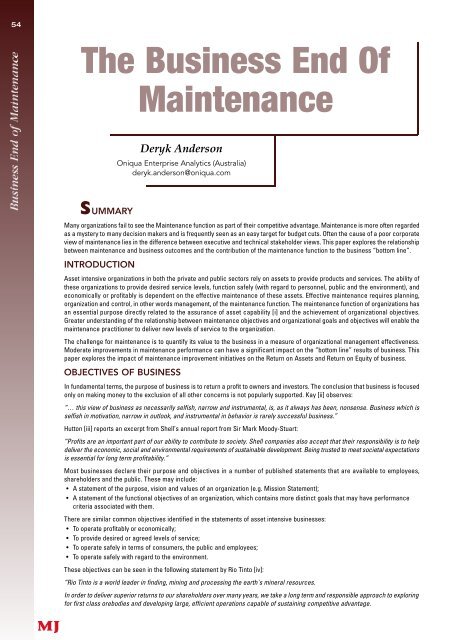October - Library - Central Queensland University
October - Library - Central Queensland University
October - Library - Central Queensland University
You also want an ePaper? Increase the reach of your titles
YUMPU automatically turns print PDFs into web optimized ePapers that Google loves.
54<br />
The Business End Of<br />
Maintenance<br />
S<br />
UMMARY<br />
Deryk Anderson<br />
Oniqua Enterprise Analytics (Australia)<br />
deryk.anderson@oniqua.com<br />
Many organizations fail to see the Maintenance function as part of their competitive advantage. Maintenance is more often re g a rd e d<br />
as a mystery to many decision makers and is frequently seen as an easy target for budget cuts. Often the cause of a poor corporate<br />
view of maintenance lies in the diff e rence between executive and technical stakeholder views. This paper explores the re l a t i o n s h i p<br />
between maintenance and business outcomes and the contribution of the maintenance function to the business “bottom line”.<br />
INTRODUCTION<br />
Asset intensive organizations in both the private and public sectors rely on assets to provide products and services. The ability of<br />
these organizations to provide desired service levels, function safely (with regard to personnel, public and the environment), and<br />
economically or profitably is dependent on the effective maintenance of these assets. Effective maintenance re q u i res planning,<br />
o rganization and control, in other words management, of the maintenance function. The maintenance function of organizations has<br />
an essential purpose directly related to the assurance of asset capability [i] and the achievement of organizational objectives.<br />
Greater understanding of the relationship between maintenance objectives and organizational goals and objectives will enable the<br />
maintenance practitioner to deliver new levels of service to the organization.<br />
The challenge for maintenance is to quantify its value to the business in a measure of organizational management effectiveness.<br />
Moderate improvements in maintenance performance can have a significant impact on the “bottom line” results of business. This<br />
paper explores the impact of maintenance improvement initiatives on the Return on Assets and Return on Equity of business.<br />
OBJECTIVES OF BUSINESS<br />
In fundamental terms, the purpose of business is to re t u rn a profit to owners and investors. The conclusion that business is focused<br />
only on making money to the exclusion of all other concerns is not popularly supported. Kay [ii] observes:<br />
“… this view of business as necessarily selfish, narrow and instrumental, is, as it always has been, nonsense. Business which is<br />
selfish in motivation, narrow in outlook, and instrumental in behavior is rarely successful business.”<br />
Hutton [iii] reports an excerpt from Shell’s annual report from Sir Mark Moody-Stuart:<br />
“Profits are an important part of our ability to contribute to society. Shell companies also accept that their responsibility is to help<br />
deliver the economic, social and environmental re q u i rements of sustainable development. Being trusted to meet societal expectations<br />
is essential for long term profitability.”<br />
Most businesses declare their purpose and objectives in a number of published statements that are available to employees,<br />
shareholders and the public. These may include:<br />
• A statement of the purpose, vision and values of an organization (e.g. Mission Statement);<br />
• A statement of the functional objectives of an organization, which contains more distinct goals that may have performance<br />
criteria associated with them.<br />
There are similar common objectives identified in the statements of asset intensive businesses:<br />
• To operate profitably or economically;<br />
• To provide desired or agreed levels of service;<br />
• To operate safely in terms of consumers, the public and employees;<br />
• To operate safely with regard to the environment.<br />
These objectives can be seen in the following statement by Rio Tinto [iv]:<br />
“Rio Tinto is a world leader in finding, mining and processing the earth's mineral resources.<br />
In order to deliver superior re t u rns to our shareholders over many years, we take a long term and responsible approach to exploring<br />
for first class orebodies and developing large, efficient operations capable of sustaining competitive advantage.
















